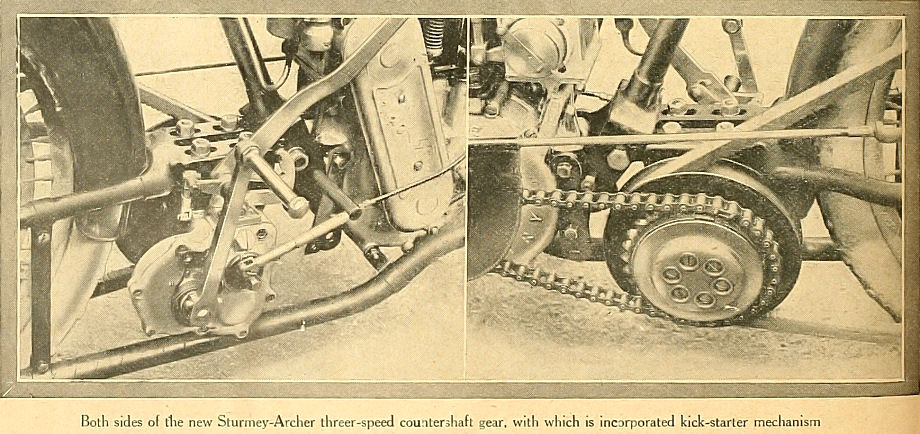


Both sides of the new Sturmey-Archer three-speed countershaft gear, with which is incorporated kick-starter mechanism
Sliding Dog Gear, giving Three Ratios; Enclosed Kick-starter; Cork Clutch.
First Trials give Great Promise.
FOR some time past Messrs. Sturmey-Archer Gears, Ltd., Nottingham, have had their new counter-shaft gear box on test both in their own factory and in the hands of various well-known motor cycle manufacturers. From all sides we hear excellent reports of its behaviour, and particularly of the wonderful way in which it is possible to change speed quietly without the use of either exhaust lifter or clutch. The gears are in constant mesh, and the change is effected by sliding dogs which lock the required pinion to the shaft. In outside appearance the box is very neat, and it is light and well made. The enclosed type kick starter is mounted on the off side, and on the near side lies the Sin. driving pulley with the chain wheel and clutch on the outside. The clutch has five plates, two of which are fitted with cork inserts, and the pressure is obtained from a series of comparatively small springs.
A Remarkably Sweet Clutch.
The illustrations herewith show the gear fitted to a 3½ h.p. Rover, on which the gear has given great satisfaction. In this case the clutch is controlled from the handle-bar, and the change speed lever is mounted on a quadrant attached to the gear box itself. Users of the gear inform us that the clutch is particularly sweet in action, and a restraint can be effected on any hill which the power permits to be climbed on the run. The Sturmey-Archer Company have had such long experience with gears that it was reasonable to expect a neat and excellent production from their works, and, marching with the times, they have adopted the bottom bracket type for their latest model. It must not be imagined that the new counter-shaft gear is merely the hub gear modified to suit a different position, for its action is quite distinct, and, with certain important modifications, follows the lines of the usual three-speed sliding gear box.
The kick starter is entirely enclosed, and is arranged so as to be conveniently placed for starting purposes. The lightness, foolproofness, and simplicity of the box combine to make it a most taking proposition, which is sure to create a large demand in the near future.
The Hub or the Countershaft Type.
It must not be imagined that Messrs. Sturmey-Archer Gears, Ltd., intend to forsake the hub gear. On the contrary, they will place both types of gear on the market with equal confidence, realising that each has its own sphere in which it is pre-eminently useful. The hub gear is always likely to have its adherents, if only because of its adaptability to belt drive, and, despite the immense advance of chain transmission, we do not believe that belts are moribund, for we doubt if chains can ever provide quite such a sweet and elastic drive as does a belt. But the advent of this gear is particularly interesting, coming, as it does, from a firm which up to the present has exerted all its power in favour of epicyclic hub gears.
The Motor Cycle, August 27th, 1914. p274.